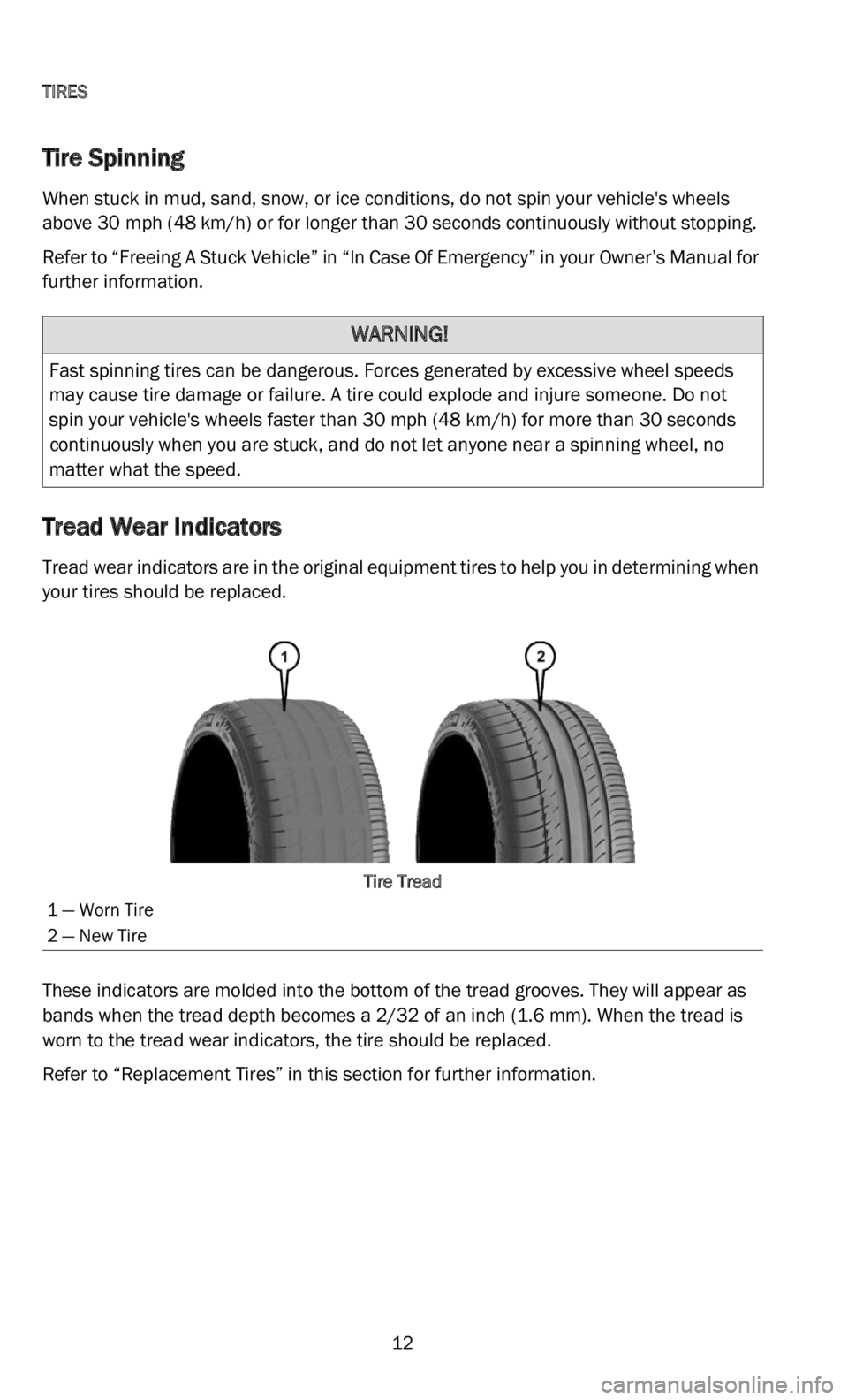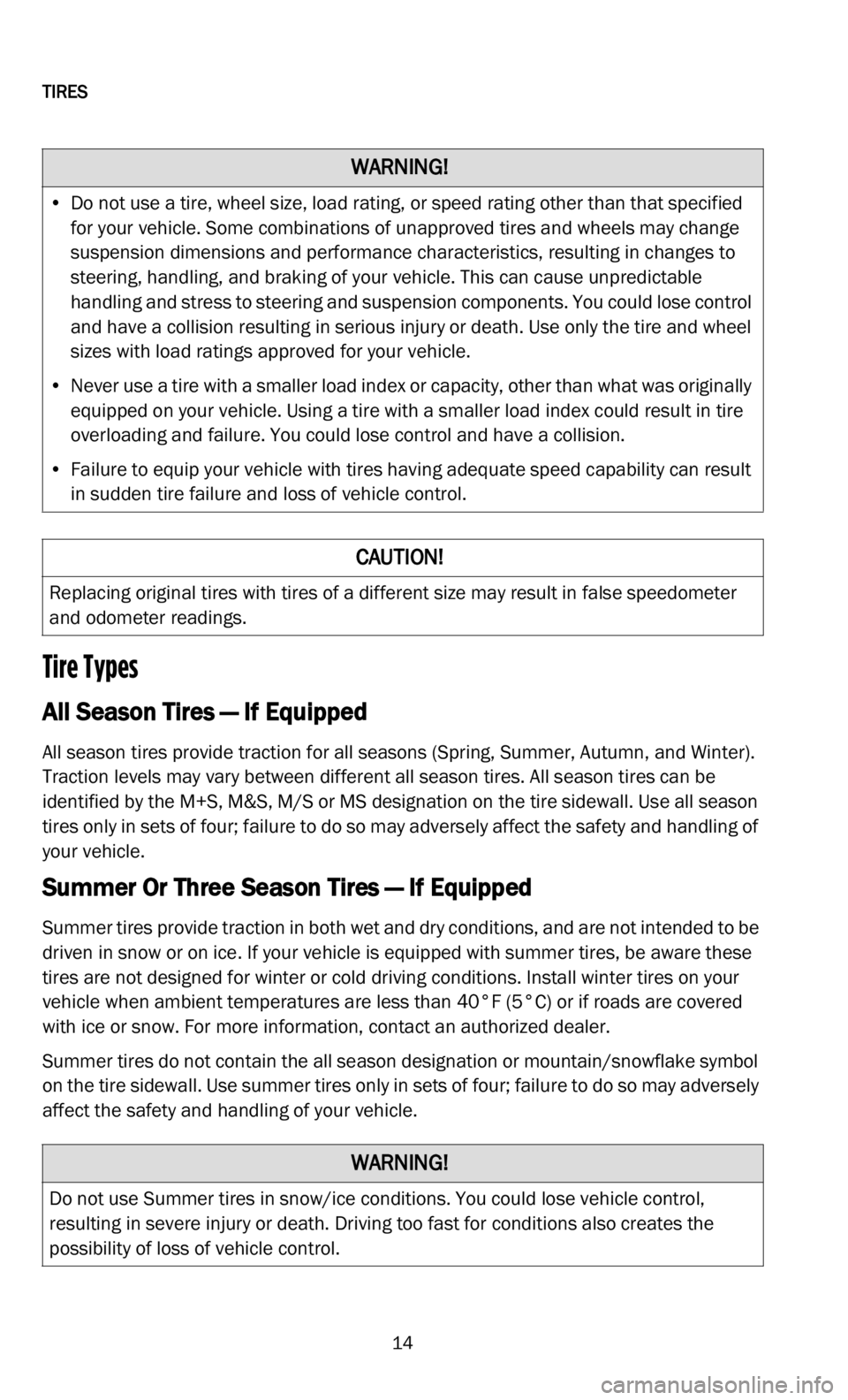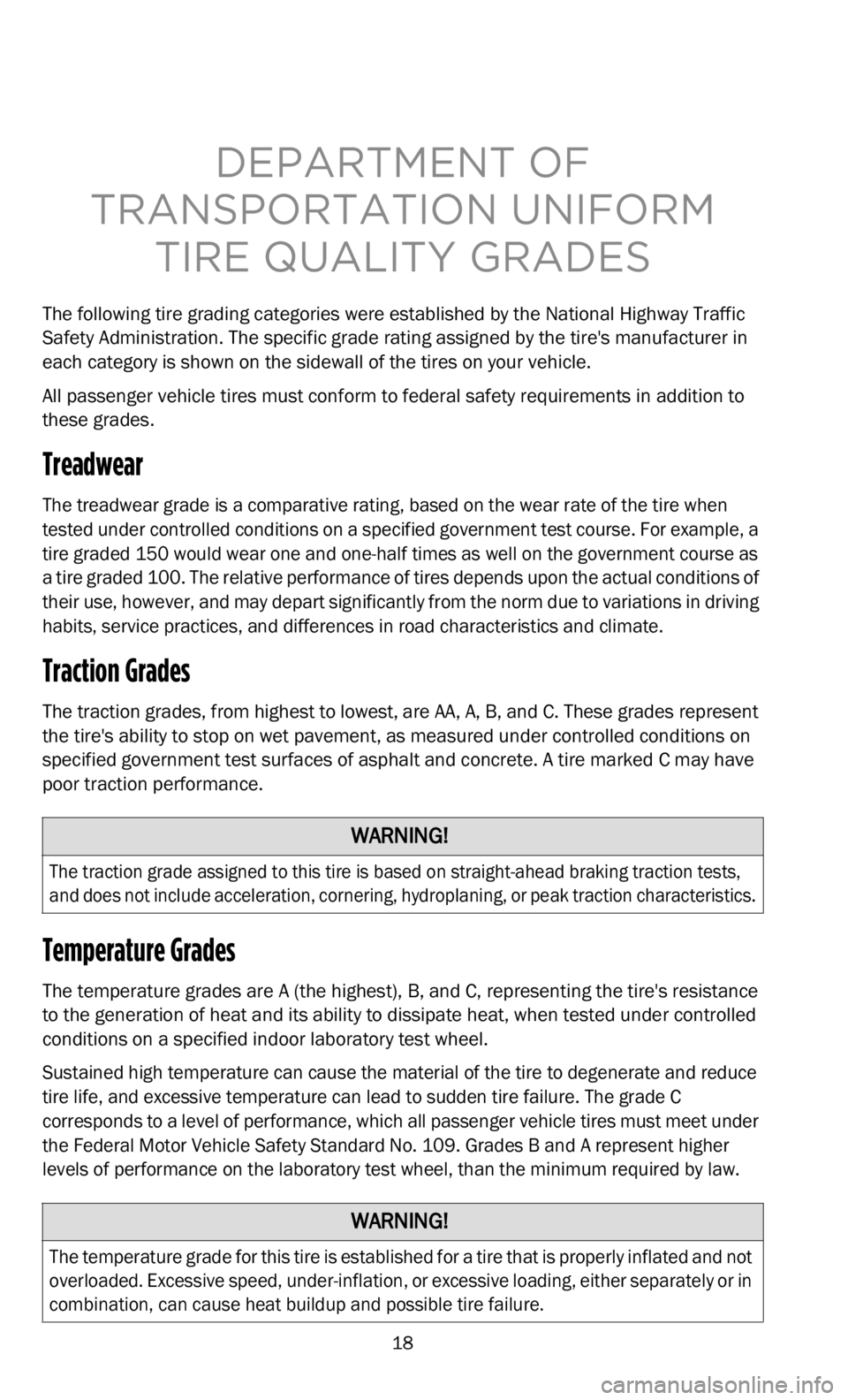DODGE CHALLENGER 2022 Vehicle Warranty
Manufacturer: DODGE, Model Year: 2022, Model line: CHALLENGER, Model: DODGE CHALLENGER 2022Pages: 200, PDF Size: 6.72 MB
Page 11 of 200

TIRES
10
Tread Wear
Improper cold tire inflation pressures can cause abnormal wear patterns and reduced
tre
ad life, resulting in the need for earlier tire replacement.
Ride Comfort And Vehicle Stability
Proper tire inflation contributes to a comfortable ride. Overinflation produces a jarring
and
uncomfortable ride.
Tire Inflation Pressures
The proper cold tire inflation pressure is listed on the driver side B-pillar or rear edge of
the driver side door.
At least once a month:
• Check and adjust tire pressure with a good quality pocket-type pressure gauge. Do notma
ke a visual judgement when determining proper inflation. Tires may look properly
inflated even when they are underinflated.
• Inspect tires for signs of tire wear or visible damage.
I n
flation pressures specified on the placard are always “cold tire inflation pressure”. Cold
ti r
e inflation pressure is defined as the tire pressure after the vehicle has not been driven
for at least three hours, or driven less than 1 mile (1.6 km) after sitting for a minimum of
th r
ee hours. The cold tire inflation pressure must not exceed the maximum inflation
pressure molded into the tire sidewall.
Check tire pressures more often if subject to a wide range of outdoor temperatures, as
ti r
e pressures vary with temperature changes.
Tire pressures change by approximately 1 psi (7 kPa) per 12°F (7°C) of air temperature
ch a
nge. Keep this in mind when checking tire pressure inside a garage, especially in the
Winter.
Example: If garage temperature = 68°F (20°C) and the outside temperature = 32°F
(0 °
C), then the cold tire inflation pressure should be increased by 3 psi
(21 kPa), which equals 1 psi (7 kPa) for every 12°F (7°C) for this outside temperature
c o n
dition.
Tire pressure may increase from 2 to 6 psi (13 to 40 kPa) during operation. DO NOT
re d
uce this normal pressure build up or your tire pressure will be too low.
CAUTION!
After inspecting or adjusting the tire pressure, always reinstall the valve stem cap. This
will prevent moisture and dirt from entering the valve stem, which could damage the
valve stem.
Page 12 of 200

TIRES
11
Tire Pressures For High Speed Operation
FCA US LLC advocates driving at safe speeds and within posted speed limits. Where
speed limits or conditions are such that the vehicle can be driven at high speeds,
maintaining correct tire inflation pressure is very important. Increased tire pressure and
reduced vehicle loading may be required for high-speed vehicle operation. Refer to an
authorized tire dealer or original equipment vehicle dealer for recommended safe
operating speeds, loading and cold tire inflation pressures.
Radial Ply Tires
Tire Repair
If your tire becomes damaged, it may be repaired if it meets the following criteria:
• The tire has not been driven on when flat.
• Th
e damage is only on the tread section of your tire (sidewall damage is not repair -
a b
le).
• The puncture is no greater than a ¼ of an inch (6 m
m).
Consult an authorized tire dealer for tire repairs and additional information.
Damaged Run Flat tires, or Run Flat tires that have experienced a loss of pressure should
be
replaced immediately with another Run Flat tire of identical size and service
description (Load Index and Speed Symbol).
Run Flat Tires — If Equipped
Run Flat tires allow you the capability to drive 50 miles (80 km) at 50 mph (80 km/h)
aft
er a rapid loss of inflation pressure. This rapid loss of inflation is referred to as the Run
Flat mode. A Run Flat mode occurs when the tire inflation pressure is of/or below 14 psi
(96 kPa). Once a Run Flat tire reaches the Run Flat mode, it has limited driving
capabilities and needs to be replaced immediately. A Run Flat tire is not repairable.
It is not recommended to drive a vehicle loaded at full capacity or to tow a trailer while a
tir
e is in the Run Flat mode.
See the Tire Pressure Monitoring System (TPMS) section for more information.
WARNING!
High speed driving with your vehicle under maximum load is dangerous. The added
strain on your tires could cause them to fail. You could have a serious collision. Do not
drive a vehicle loaded to maximum capacity at continuous speeds above 75 mph
(1 2
0 km/h).
WARNING!
Combining radial ply tires with other types of tires on your vehicle will cause your
vehicle to handle poorly. The instability could cause a collision. Always use radial ply
tires in sets of four. Never combine them with other types of tires.
Page 13 of 200

TIRES
12
Tire Spinning
When stuck in mud, sand, snow, or ice conditions, do not spin your vehicle's wheels
above 30 mph (48 km/h) or for longer than 30 seconds continuously without stopping.
Refer to “Freeing A Stuck Vehicle” in “In Case Of Emergency” in your Owner’s Manual for
fu r
ther information.
Tread Wear Indicators
Tread wear indicators are in the original equipment tires to help you in determining when
your tires should be replaced.
Tire Tread
These indicators are molded into the bottom of the tread grooves. They will appear as
bands when the tread depth becomes a 2/32 of an inch (1.6 mm). When the tread is
wo r
n to the tread wear indicators, the tire should be replaced.
Refer to “Replacement Tires” in this section for further information.
WARNING!
Fast spinning tires can be dangerous. Forces generated by excessive wheel speeds
may cause tire damage or failure. A tire could explode and injure someone. Do not
spin your vehicle's wheels faster than 30 mph (48 km/h) for more than 30 seconds
co n
tinuously when you are stuck, and do not let anyone near a spinning wheel, no
matter what the speed.
1 — Worn Tire
2 — New Tire
Page 14 of 200

TIRES
13
Life Of Tire
The service life of a tire is dependent upon varying factors including, but not limited to:
• D riving style.
•
Tire pressure - Improper cold tire inflation pressures can cause uneven wear patterns
t
o develop across the tire tread. These abnormal wear patterns will reduce tread life,
resulting in the need for earlier tire replacement.
• D istance driven.
•
Performance tires, tires with a speed rating of V or higher, and Summer tires typically
h
ave a reduced tread life. Rotation of these tires per the vehicle scheduled mainte -
nance is highly recommended.
Keep dismounted tires in a cool, dry place with as little exposure to light as possible.
P r
otect tires from contact with oil, grease, and gasoline.
Replacement Tires
The tires on your new vehicle provide a balance of many characteristics. They should be
inspected regularly for wear and correct cold tire inflation pressures. FCA US LLC strongly
recommends that you use tires equivalent to the originals in size, quality and
performance when replacement is needed. Refer to the paragraph on “Tread Wear
Indicators” in this section. Refer to the Tire and Loading Information placard or the
Vehicle Certification Label for the size designation of your tires. The Load Index and
Speed Symbol for your tires will be found on the original equipment tire sidewall.
See the Tire Sizing Chart example found in the “Tire Safety Information” section of this
ma
nual for more information relating to the Load Index and Speed Symbol of a tire.
It is recommended to replace the two front tires or two rear tires as a pair. Replacing just
o n
e tire can seriously affect your vehicle’s handling. If you ever replace a wheel, make
sure that the wheel’s specifications match those of the original wheels.
It is recommended you contact an authorized tire dealer or original equipment dealer with
a n
y questions you may have on tire specifications or capability. Failure to use equivalent
replacement tires may adversely affect the safety, handling, and ride of your vehicle.
WARNING!
Tires and the spare tire should be replaced after six years, regardless of the remaining
tread. Failure to follow this warning can result in sudden tire failure. You could lose
control and have a collision resulting in serious injury or death.
Page 15 of 200

TIRES
14
Tire Types
All Season Tires — If Equipped
All season tires provide traction for all seasons (Spring, Summer, Autumn, and Winter).
Traction levels may vary between different all season tires. All season tires can be
identified by the M+S, M&S, M/S or MS designation on the tire sidewall. Use all season
tires only in sets of four; failure to do so may adversely affect the safety and handling of
your vehicle.
Summer Or Three Season Tires — If Equipped
Summer tires provide traction in both wet and dry conditions, and are not intended to be
driven in snow or on ice. If your vehicle is equipped with summer tires, be aware these
tires are not designed for winter or cold driving conditions. Install winter tires on your
vehicle when ambient temperatures are less than 40°F (5°C) or if roads are covered
with ice or snow. For more information, contact an authorized dealer.
Summer tires do not contain the all season designation or mountain/snowflake symbol
on
the tire sidewall. Use summer tires only in sets of four; failure to do so may adversely
affect the safety and handling of your vehicle.
WARNING!
• Do not use a tire, wheel size, load rating, or speed rating other than that specified for your vehicle. Some combinations of unapproved tires and wheels may change
suspension dimensions and performance characteristics, resulting in changes to
steering, handling, and braking of your vehicle. This can cause unpredictable
handling and stress to steering and suspension components. You could lose control
and have a collision resulting in serious injury or death. Use only the tire and wheel
sizes with load ratings approved for your vehicle.
• Never use a tire with a smaller load index or capacity, other than what was originally eq
uipped on your vehicle. Using a tire with a smaller load index could result in tire
overloading and failure. You could lose control and have a collision.
• Failure to equip your vehicle with tires having adequate speed capability can result in
sudden tire failure and loss of vehicle control.
CAUTION!
Replacing original tires with tires of a different size may result in false speedometer
and odometer readings.
WARNING!
Do not use Summer tires in snow/ice conditions. You could lose vehicle control,
resulting in severe injury or death. Driving too fast for conditions also creates the
possibility of loss of vehicle control.
Page 16 of 200

TIRES
15
Snow Tires
Some areas of the country require the use of snow tires during the winter. Snow tires can
be identified by a “mountain/snowflake” symbol on the tire sidewall. If you need snow tires, select tires equivalent in size and type to the original
equipment tires. Use snow tires only in sets of four; failure to do so may
ad
versely affect the safety and handling of your vehicle.
Snow tires generally have lower speed ratings than what was originally equipped with
y o
ur vehicle and should not be operated at sustained speeds over 75 mph (120 km/h).
F o
r speeds above 75 mph (120 km/h) refer to original equipment or an authorized tire
d e
aler for recommended safe operating speeds, loading and cold tire inflation
pressures.
While studded tires improve performance on ice, skid and traction capability on wet or
d r
y surfaces may be poorer than that of non-studded tires. Some states prohibit studded
tires; therefore, local laws should be checked before using these tire types.
Spare Tires — If Equipped
Spare Tire Matching Original Equipped Tire And Wheel —
If Equipped
Your vehicle may be equipped with a spare tire and wheel equivalent in look and function
to the original equipment tire and wheel found on the front or rear axle of your vehicle.
This spare tire may be used in the tire rotation for your vehicle. If your vehicle has this
option, refer to an authorized tire dealer for the recommended tire rotation pattern.
Compact Spare Tire — If Equipped
The compact spare is for temporary emergency use only. You can identify if your vehicle
is equipped with a compact spare by looking at the spare tire description on the Tire and
Loading Information Placard located on the driver side door opening or on the sidewall
of the tire. Compact spare tire descriptions begin with the letter “T” or “S” preceding the
size designation. Example: T145/80D18 103M.
T, S = Temporary Spare Tire
Since this tire has limited tread life, the original equipment tire should be repaired (or
r e
placed) and reinstalled on your vehicle at the first opportunity.
Do not install a wheel cover or attempt to mount a conventional tire on the compact
s p
are wheel, since the wheel is designed specifically for the compact spare tire. Do not
install more than one compact spare tire and wheel on the vehicle at any given time.
CAUTION!
Because of the reduced ground clearance, do not take your vehicle through an
automatic car wash with a compact or limited use temporary spare installed. Damage
to the vehicle may result.
Page 17 of 200

TIRES
16
Collapsible Spare Tire — If Equipped
The collapsible spare is for temporary emergency use only. You can identify if your vehicle
is equipped with a collapsible spare by looking at the spare tire description on the Tire
and Loading Information Placard located on the driver side door opening or on the
sidewall of the tire.
Collapsible spare tire description example: 165/80-17 101P.
Since this tire has limited tread life, the original equipment tire should be repaired (or
re
placed) and reinstalled on your vehicle at the first opportunity.
Inflate the collapsible tire only after the wheel is properly installed on the vehicle. Inflate
t h
e collapsible tire using the electric air pump before lowering the vehicle.
Do not install a wheel cover or attempt to mount a conventional tire on the collapsible
s p
are wheel, since the wheel is designed specifically for the collapsible spare tire.
Full Size Spare — If Equipped
The full size spare is for temporary emergency use only. This tire may look like the
originally equipped tire on the front or rear axle of your vehicle, but it is not. This spare
tire may have limited tread life. When the tread is worn to the tread wear indicators, the
temporary use full size spare tire needs to be replaced. Since it is not the same as your
original equipment tire, replace (or repair) the original equipment tire and reinstall on the
vehicle at the first opportunity.
WARNING!
Compact and collapsible spares are for temporary emergency use only. With these
spares, do not drive more than 50 mph (80 km/h). Temporary use spares have limited
t r
ead life. When the tread is worn to the tread wear indicators, the temporary use
spare tire needs to be replaced. Be sure to follow the warnings, which apply to your
spare. Failure to do so could result in spare tire failure and loss of vehicle control.
WARNING!
Compact and Collapsible spares are for temporary emergency use only. With these
spares, do not drive more than 50 mph (80 km/h). Temporary use spares have limited
t r
ead life. When the tread is worn to the tread wear indicators, the temporary use
spare tire needs to be replaced. Be sure to follow the warnings, which apply to your
spare. Failure to do so could result in spare tire failure and loss of vehicle control.
Page 18 of 200

TIRES
17
Limited Use Spare — If Equipped
The limited use spare tire is for temporary emergency use only. This tire is identified by
a label located on the limited use spare wheel. This label contains the driving limitations
for this spare. This tire may look like the original equipped tire on the front or rear axle of
your vehicle, but it is not. Installation of this limited use spare tire affects vehicle
handling. Since it is not the same as your original equipment tire, replace (or repair) the
original equipment tire and reinstall on the vehicle at the first opportunity.
WARNING!
Limited use spares are for emergency use only. Installation of this limited use spare
tire affects vehicle handling. With this tire, do not drive more than the speed listed on
the limited use spare wheel. Keep inflated to the cold tire inflation pressures listed on
your Tire and Loading Information Placard located on the driver’s side B-Pillar or the
rear edge of the driver’s side door. Replace (or repair) the original equipment tire at
the first opportunity and reinstall it on your vehicle. Failure to do so could result in loss
of vehicle control.
Page 19 of 200

18
DEPARTMENT OF
TRANSPORTATION UNIFORM TIRE QUALITY GRADES
The following tire grading categories were established by the National Highway Traffic
Safety Administration. The specific grade rating assigned by the tire's manufacturer in
each category is shown on the sidewall of the tires on your vehicle.
All passenger vehicle tires must conform to federal safety requirements in addition to
the
se grades.
Treadwear
The treadwear grade is a comparative rating, based on the wear rate of the tire when
tested under controlled conditions on a specified government test course. For example, a
tire graded 150 would wear one and one-half times as well on the government course as
a tire graded 100. The relative performance of tires depends upon the actual conditions of
their use, however, and may depart significantly from the norm due to variations in driving
habits, service practices, and differences in road characteristics and climate.
Traction Grades
The traction grades, from highest to lowest, are AA, A, B, and C. These grades represent
the tire's ability to stop on wet pavement, as measured under controlled conditions on
specified government test surfaces of asphalt and concrete. A tire marked C may have
poor traction performance.
Temperature Grades
The temperature grades are A (the highest), B, and C, representing the tire's resistance
to the generation of heat and its ability to dissipate heat, when tested under controlled
conditions on a specified indoor laboratory test wheel.
Sustained high temperature can cause the material of the tire to degenerate and reduce
tir
e life, and excessive temperature can lead to sudden tire failure. The grade C
corresponds to a level of performance, which all passenger vehicle tires must meet under
the Federal Motor Vehicle Safety Standard No. 109. Grades B and A represent higher
levels of performance on the laboratory test wheel, than the minimum required by law.
WARNING!
The traction grade assigned to this tire is based on straight-ahead braking traction tests,
and does not include acceleration, cornering, hydroplaning, or peak traction characteristics.
WARNING!
The temperature grade for this tire is established for a tire that is properly inflated and not
overloaded. Excessive speed, under-inflation, or excessive loading, either separately or in
combination, can cause heat buildup and possible tire failure.
Page 20 of 200

19
TIRE WARRANTY
Tire Limited Warranty And Adjustment Policy
When a tire is removed from service due to a covered warranty condition under a tire
manufacturer’s “Limited Warranty Program”, you may be eligible for a free tire
replacement or a comparable new tire on a prorated basis.
Certain conditions, such as irregular wear or tire damage due to road hazards, collision,
imp
roper inflation, intentional alteration, and misuse, are excluded from the Limited
Warranty Program. The Limited Warranty Program expires when your tires either wear to
a specified tread depth, and/or after a period of time from the date of purchase, as
stated in the Tire Warranty in this manual.
NOTE:
Refer to the Tire Warranty in this manual for specific information relating to the tire
m an
ufacturer’s limited warranty for the tires installed on your vehicle. If you have any
questions regarding the limited tire warranty coverage, contact your local authorized
dealer or your local authorized tire dealer.
Disclaimer:
THE MOST UP-TO-DATE INFORMATION FOR THE TIRE MANUFACTURER’S LIMITED
WAR
RANTY PROGRAM CAN BE ACCESSED THROUGH THE SPECIFIC TIRE
MANUFACTURER’S WEBSITE.
THE TIRE MANUFACTURER’S LIMITED WARRANTY PROGRAM, THE DETAILS OF WHICH
CA N
BE FOUND IN THIS MANUAL, THE TIRE MANUFACTURER’S WEBSITE OR AT ANY
AUTHORIZED SERVICE CENTER ARE IN LIEU OF ALL OTHER REMEDIES OR WARRANTIES,
EXPRESS OR IMPLIED, ARISING BY LAW OR OTHERWISE, INCLUDING FITNESS FOR A
PARTICULAR PURPOSE OR MERCHANTABILITY. THE TIRE MANUFACTURER EXPRESSLY
DISCLAIMS LIABILITY FOR INDIRECT, SPECIAL, INCIDENTAL OR CONSEQUENTIAL
DAMAGES, LOST PROFIT, LOSS OF BUSINESS, LOSS OF GOODWILL, LOSS OF
REPUTATION, PUNITIVE OR ANY OTHER DAMAGE, COST OR LOSS OF ANY KIND. SOME
STATES AND PROVINCES DO NOT ALLOW THE EXCLUSION OR LIMITATION OF
INCIDENTAL OR CONSEQUENTIAL DAMAGES, SO THE ABOVE LIMITATION OR EXCLUSION
MAY NOT APPLY TO YOU.
WARNING!
Refer to the Owner’s Manual online for complete warning information that could
prevent accidents, injuries and even deaths.